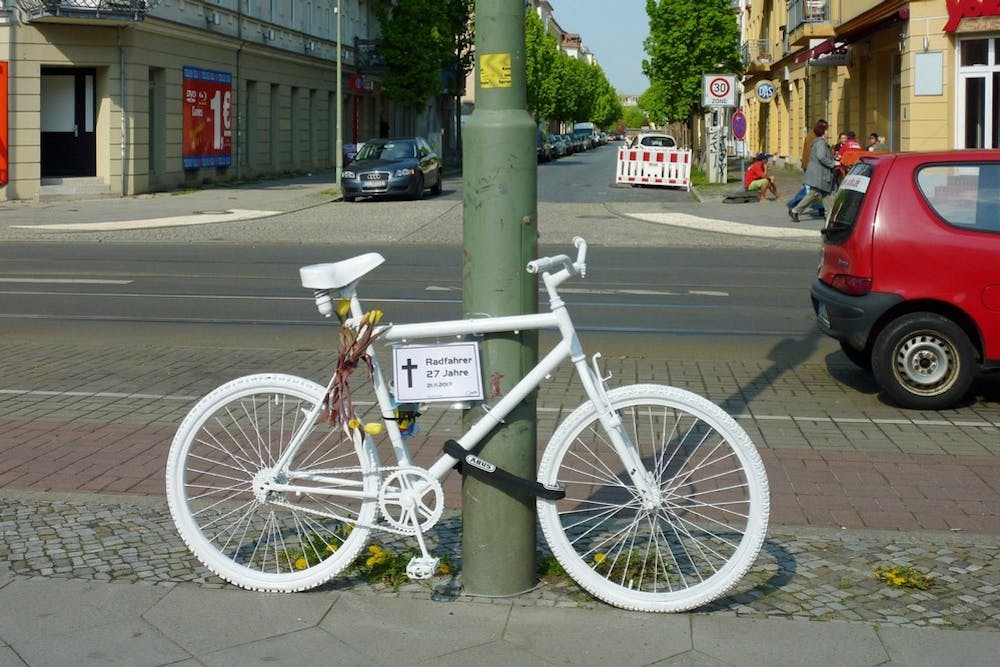There are currently four ghost bikes in Durham, and a recent project at Duke seeks to make sure there are no more.
Ghost bikes are white-painted bicycles that mark where cyclists have been hit or killed on the street. Across the world, the bikes serve as memorials and reminders for passing motorists to share the road.
But a new study by the Duke Information Initiative has proposed ways to improve traffic safety for both Durham bicyclists and pedestrians.
During the summer, Duke students in the initiative partnered with the Durham Department of Transportation to devise ways to improve traffic safety for Durham bicyclists and pedestrians. The team created an interactive website and app that helps users see how different factors like time of day, weather and road conditions affect accident risk. The study also produced a set of policy recommendations to help local government agencies to reduce car accidents with bicyclists and pedestrians.
“I hope that, as bicycle safety is taken more seriously, our recommendations will be adopted,” said junior Elizabeth Ratliff, who worked on the project. "I think that for cities that have especially large public transport, it is also really crucial that these changes are made.”
The researchers' website includes maps of where bicycle accidents are most common. The app will also allow the city to input new data as it becomes available.
The students came up with the idea for the study after Harris Solomon, an associate professor of cultural anthropology and global health, led a seminar last semester that explored how ghost bikes function as memorials.
To construct the website, Ratliff and Lauren Fox, Trinity '17, indexed more than 20 datasets from police reports using a platform called QGIS. Solomon said integrating data from different sources was the biggest challenge.
“Data sources rarely line up neatly, whether those sources come from a city planning database or from photographs of a memorial,” he wrote in an email. “It is the dissonances between data that the students grappled with the most.”
Aside from the website, the study recommends that policymakers remodel high-density crash sites into complete streets with median islands and bicycle lanes. Ratliff said that more than 75 percent of car crashes involving bicyclists or pedestrians occur on two-way, undivided roads.
“A two-way, not divided street does not have a median or a shoulder,” she said. “The reason why these are so dangerous is because bicyclists and pedestrians literally have nowhere to go.”
Fox wrote in an email that the study also found that more crosswalks could also be useful on two-way streets where pedestrians are likely to cross mid-block.
“If you have ever been on Hillsborough Road, you have probably seen people cross in the middle of a road, which puts them at a higher risk of getting hit because cars are not expecting them,” Fox wrote.
Among their other findings, Ratliff and Fox also discovered that males, who make up approximately two-thirds of bicyclists over the age of 16, are victims in 75 percent of bicycle crashes. Ratliff said that this trend was particularly surprising.
“We don’t know if this is because there are simply more male bicyclists on the road, or just because men are riding more recklessly or men are bigger objects to hit or whatever,” she explained. “But I would say that was very noteworthy.”
Solomon noted that he believes the proposed safety recommendations will be adopted. He said the researchers worked with the community to brainstorm the suggestions.
“The research was designed from the very beginning through conversations with community partners," he wrote. "Because they wanted their work to be actionable, the chances of adoption are far, far greater than if they worked in isolation.”
Dale McKeel, bicycle and pedestrian coordinator for the Durham Department of Transportation, also said the recommendations support Durham’s plan to become part of the Vision Zero program, which is a multi-national road traffic safety project that seeks to eliminate traffic fatalities and serious injuries worldwide.
“I think these recommendations fit right in with our Vision Zero program,” McKeel said. “Fatalities on our highways are unacceptable. These recommendations and this work will aid us in reaching this new goal that we set for ourselves.”
Still, Ratliff and Fox explained that their safety proposals may be limited by cost and certain emergency vehicle requirements. Some roads are left wide so as to appease nearby constituents and allow emergency vehicles to travel more quickly through traffic.
Get The Chronicle straight to your inbox
Sign up for our weekly newsletter. Cancel at any time.
Ratliff added that the projects supported by the research would be “pretty expensive” and that the city often directs its limited funding to making streets safer for cars.
“Cars have significantly more safety precautions, whereas with bicycles, anybody can ride,” Ratliff explained. “I don’t think that there should be licenses for bicycles, but I do think that there should be more precautions. A lot of damage can come to a bicyclist.”

